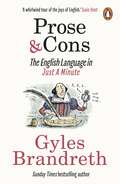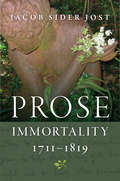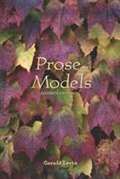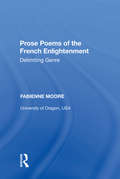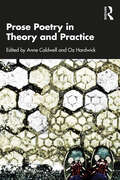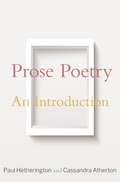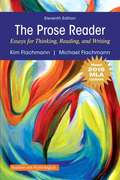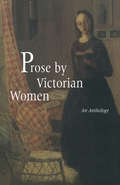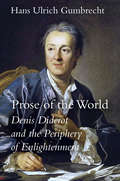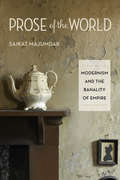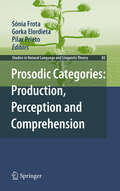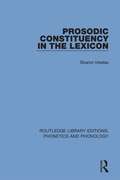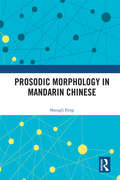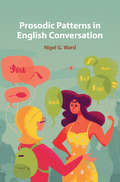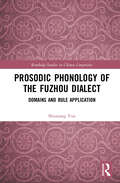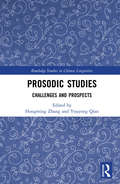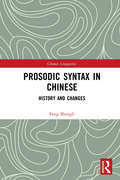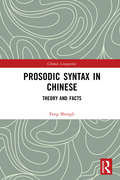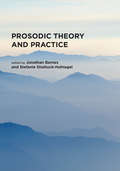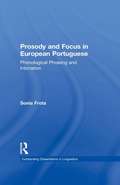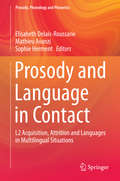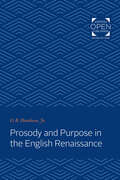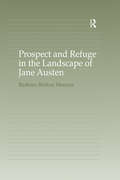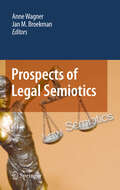- Table View
- List View
Prose & Cons: The English Language in Just A Minute
by Gyles BrandrethAs fans of Just a Minute know, the key to the game is knowing your way around the English language: how it works, how it’s evolved, and how words connect, often in surprising ways. When it comes to the English language (and Just a Minute), Gyles Brandreth has seen it all – and now he’s ready to put you through your linguistic paces, to become a Just a Minute expert yourself.In this wildly entertaining A to Z of verbal acrobatics, Gyles takes you on a whirlwind tour of our mother tongue – from the origins of words and correct grammar and punctuation, to similes, euphemisms and record breaking tongue twisters (try getting your mouth around floccinaucinihilipification!). An idiosyncratic blend of history, word play, anecdote, and hyperbole, all in 60-second instalments, this is Gyles Brandreth at his word-perfect, Just-a-Minute best. You’ll never mix your metaphors again...
Prose Immortality, 1711-1819
by Jacob Sider JostWriters have always aspired to immortality, using their works to preserve their patrons, their loved ones, and themselves beyond death. For Pindar, Horace, and Shakespeare, the vehicle of such preservation was poetry. In the eighteenth century, figures such as Joseph Addison, Edward Young, Samuel Richardson, Laetitia Pilkington, Samuel Johnson, and James Boswell invented a new kind of literary immortality, built on the documentary power of prose. For eighteenth-century authors, the rhythms and routines of daily lived experience were too rich to be distilled into verse, and prose genres such as the periodical paper, novel, memoir, essay, and biography promised a new kind of lastingness that responded to the challenges and opportunities of Enlightenment philosophy and evolving religious thought. Prose Immortality, 1711-1819documents this transformation of British literary culture, spanning the eighteenth century and linking journalism, literature, theology, and philosophy. In recovering the centrality of the afterlife to eighteenth-century culture, this prizewinning book offers a versatile and wide-ranging argument that will speak not only to literary scholars but also to historians, scholars of religion, and all readers interested in the power of literature to preserve human experience through time. Winner of the Walker Cowen Memorial Prize for an Outstanding Work of Scholarship in Eighteenth-Century Studies
Prose Models (11th Edition)
by Gerald LevinContaining over 110 selections by contemporary and classic writers, PROSE MODELS is a rhetorical reader that covers the major elements of paragraph, essay and methods of development with an emphasis on Argument and Persuasive writing.
Prose Poems of the French Enlightenment: Delimiting Genre
by Fabienne MooreBy examining nearly sixty works, the author traces the prehistory of the French prose poem, demonstrating that the disquiet of some eighteenth-century writers with the Enlightenment gave rise to the genre nearly a century before it is habitually supposed to have existed. In the throes of momentous scientific, philosophical, and socioeconomic changes, Enlightenment authors turned to the past to revive sources such as Homer, the pastoral, Ossian, the Bible, and primitive eloquence, favoring music to construct alternatives to the world of reason. The result, the author argues, were prose poems, including F lon's Les Adventures de T maque, Montesquieu's Le Temple de Gnide, Rousseau's Le L te d'Ephraïm, Chateaubriand's Atala, as well as many lesser-known texts, most of which remain out of print. The author's treatment of Bible criticism and eighteenth-century religious reform movements reveal the often-neglected spiritual side of Enlightenment culture, and tracks its contribution to the period's reflection about language and poetic invention. The author includes in appendices four unusual texts adjudicating the merits of prose poems, making evidence of their controversial nature now accessible to readers.
Prose Poetry in Theory and Practice
by Anne CaldwellProse Poetry in Theory and Practice vigorously engages with the Why? and the How? of prose poetry, a form that is currently enjoying a surge in popularity. With contributions by both practitioners and academics, this volume seeks to explore how its distinctive properties guide both writer and reader, and to address why this form is so well suited to the early twenty-first century. With discussion of both classic and less well-known writers, the essays both illuminate prose poetry’s distinctive features and explore how this “outsider” form can off er a unique way of viewing and describing the uncertainties and instabilities which shape our identities and our relationships with our surroundings in the early twenty-first century. Combining insights on the theory and practice of prose poetry, Prose Poetry in Theory and Practice off ers a timely and valuable contribution to the development of the form, and its appreciation amongst practitioners and scholars alike. Largely approached from a practitioner perspective, this collection provides vivid snapshots of contemporary debates within the prose poetry field while actively contributing to the poetics and craft of the form.
Prose Poetry in Theory and Practice
by Anne CaldwellProse Poetry in Theory and Practice vigorously engages with the Why? and the How? of prose poetry, a form that is currently enjoying a surge in popularity. With contributions by both practitioners and academics, this volume seeks to explore how its distinctive properties guide both writer and reader, and to address why this form is so well suited to the early twenty-first century. With discussion of both classic and less well- known writers, the essays both illuminate prose poetry’s distinctive features and explore how this "outsider" form can offer a unique way of viewing and describing the uncertainties and instabilities which shape our identities and our relationships with our surroundings in the early twenty-first century. Combining insights on the theory and practice of prose poetry, Prose Poetry in Theory and Practice offers a timely and valuable contribution to the development of the form, and its appreciation amongst practitioners and scholars alike. Largely approached from a practitioner perspective, this collection provides vivid snapshots of contemporary debates within the prose poetry field while actively contributing to the poetics and craft of the form.
Prose Poetry: An Introduction
by Paul Hetherington Cassandra AthertonAn engaging and authoritative introduction to an increasingly important and popular literary genreProse Poetry is the first book of its kind—an engaging and authoritative introduction to the history, development, and features of English-language prose poetry, an increasingly important and popular literary form that is still too little understood and appreciated. Poets and scholars Paul Hetherington and Cassandra Atherton introduce prose poetry’s key characteristics, chart its evolution from the nineteenth century to the present, and discuss many historical and contemporary prose poems that both demonstrate their great diversity around the Anglophone world and show why they represent some of today’s most inventive writing.A prose poem looks like prose but reads like poetry: it lacks the line breaks of other poetic forms but employs poetic techniques, such as internal rhyme, repetition, and compression. Prose Poetry explains how this form opens new spaces for writers to create riveting works that reshape the resources of prose while redefining the poetic. Discussing prose poetry’ s precursors, including William Wordsworth and Walt Whitman, and prose poets such as Charles Simic, Russell Edson, Lydia Davis, and Claudia Rankine, the book pays equal attention to male and female prose poets, documenting women’s essential but frequently unacknowledged contributions to the genre.Revealing how prose poetry tests boundaries and challenges conventions to open up new imaginative vistas, this is an essential book for all readers, students, teachers, and writers of prose poetry.
Prose Reader Essays for Thinking, Reading and Writing, MLA Update
by Kim Flachmann Michael FlachmannFor courses in first-year composition. This version of The Prose Reader: Essays for Thinking, Reading and Writing has been updated to reflect the 8th Edition of the MLA Handbook (April 2016)* Organized by rhetorical modes to showcase contemporary works by diverse authors Lucid writing follows lucid thinking - and The Prose Reader, Eleventh Edition helps students think more clearly and logically in their minds and on paper. Organized by rhetorical pattern, this reader builds upon critical thinking as the foundation for close reading and effective writing. Numerous discussion questions and writing assignments for each selection lead students from literal-level responses to interpretation and analysis. These questions, and the essays they frame, immerse students in some of the best examples of professional prose available today. * The 8th Edition introduces sweeping changes to the philosophy and details of MLA works cited entries. Responding to the "increasing mobility of texts," MLA now encourages writers to focus on the process of crafting the citation, beginning with the same questions for any source. These changes, then, align with current best practices in the teaching of writing which privilege inquiry and critical thinking over rote recall and rule-following.
Prose by Victorian Women: An Anthology
by Andrea Broomfield Sally MitchellFirst published in 1996. Routledge is an imprint of Taylor & Francis, an informa company.
Prose of the World: Denis Diderot and the Periphery of Enlightenment
by Hans Ulrich GumbrechtA lively examination of the life and work of one of the great Enlightenment intellectuals Philosopher, translator, novelist, art critic, and editor of the Encyclopédie, Denis Diderot was one of the liveliest figures of the Enlightenment. But how might we delineate the contours of his diverse oeuvre, which, unlike the works of his contemporaries, Voltaire, Rousseau, Schiller, Kant, or Hume, is clearly characterized by a centrifugal dynamic? Taking Hegel's fascinated irritation with Diderot's work as a starting point, Hans Ulrich Gumbrecht explores the question of this extraordinary intellectual's place in the legacy of the eighteenth century. While Diderot shared most of the concerns typically attributed to his time, the ways in which he coped with them do not fully correspond to what we consider Enlightenment thought. Conjuring scenes from Diderot's by turns turbulent and quiet life, offering close readings of several key books, and probing the motif of a tension between physical perception and conceptual experience, Gumbrecht demonstrates how Diderot belonged to a vivid intellectual periphery that included protagonists such as Lichtenberg, Goya, and Mozart. With this provocative and elegant work, he elaborates the existential preoccupations of this periphery, revealing the way they speak to us today.
Prose of the World: Modernism and the Banality of Empire
by Saikat MajumdarEveryday life in the far outposts of empire can be static, empty of the excitement of progress. A pervading sense of banality and boredom are, therefore, common elements of the daily experience for people living on the colonial periphery. Saikat Majumdar suggests that this impoverished affective experience of colonial modernity significantly shapes the innovative aesthetics of modernist fiction. Prose of the World explores the global life of this narrative aesthetic, from late-colonial modernism to the present day, focusing on a writer each from Ireland, New Zealand, South Africa, and India. Ranging from James Joyce's deflated epiphanies to Amit Chaudhuri's disavowal of the grand spectacle of postcolonial national allegories, Majumdar foregrounds the banal as a key instinct of modern and contemporary fiction—one that nevertheless remains submerged because of its antithetical relation to literature's intuitive function to engage or excite. Majumdar asks us to rethink the assumption that banality merely indicates an aesthetic failure. If narrative is traditionally enabled by the tremor, velocity, and excitement of the event, the historical and affective lack implied by the banal produces a narrative force that is radically new precisely because it suspends the conventional impulses of narration.
Prosodic Categories: Production, Perception and Comprehension
by Gorka Elordieta Sónia Frota Pilar PrietoLocated at the intersection of phonology, psycholinguistics and phonetics, this volume offers the latest research findings in key areas of prosodic theory, including: *The relationship between intonation and pragmatics in speech production *Sentence modality prosody characterization *The role of pitch in quantity-based sound systems *Consonant-conditioned tone depression phonology across languages *The encoding of intonational contrasts in both intonational and tonal languages Featuring new data and ground-breaking results, the papers draw on empirical approaches that analyze production, perception and comprehension experiments such as the prepared speech paradigm and semantic scaling tasks. These are discussed in a variety of languages, some underrepresented in the literature (such as French and Estonian) while others, such as Shekgalagari, are examined in this way for the first time. This collection of cutting-edge material will be of interest to a broad range of language researchers.
Prosodic Constituency in the Lexicon (Routledge Library Editions: Phonetics and Phonology #9)
by Sharon InkelasFirst published in 1990. This study introduces Prosodic Lexical Phonology, a theory of morphology-phonology interaction. This theory unifies the theoretical treatments of lexical and postlexical phonological rule application. It also provides an explanatory account of systematic discrepancies that have been observed between the parsing of strings for purposes of the morphology, and the parsing of those strings into domains of phonological rule application. This title will be of interest to students of language and linguistics.
Prosodic Morphology in Mandarin Chinese
by Shengli FengIt is not entirely clear if modern Chinese is a monosyllabic or disyllabic language. Although a disyllabic prosodic unit of some sort has long been considered by many to be at play in Chinese grammar, the intuition is not always rigidly fleshed out theoretically in the area of Chinese morphology. In this book, Shengli Feng applies the theoretical model of prosodic morphology to Chinese morphology to provide the theoretical clarity regarding how and why Mandarin Chinese words are structured in a particular way. All of the facts generated by the system of prosodic morphology in Chinese provide new perspectives for linguistic theory, as well as insights for teaching Chinese and studying of Chinese poetic prosody.
Prosodic Patterns in English Conversation
by Nigel G. WardLanguage is more than words: it includes the prosodic features and patterns that we use, subconsciously, to frame meanings and achieve our goals in our interaction with others. Here, Nigel G. Ward explains how we do this, going beyond intonation to show how pitch, timing, intensity and voicing properties combine to form meaningful temporal configurations: prosodic constructions. Bringing together new findings and hitherto-scattered observations from phonetic and pragmatic studies, this book describes over twenty common prosodic patterns in English conversation. Using examples from real conversations, it illustrates how prosodic constructions serve essential functions such as inviting, showing approval, taking turns, organizing ideas, reaching agreement, and evoking action. Prosody helps us establish rapport and nurture relationships, but subtle differences in prosody across languages and subcultures can be damagingly misunderstood. The findings presented here will enable both native speakers of English and learners to listen more sensitively and communicate more effectively.
Prosodic Phonology of the Fuzhou Dialect: Domains and Rule Application (Routledge Studies in Chinese Linguistics)
by Shuxiang YouProsodic Phonology of the Fuzhou Dialect: Domains and Rule Application is the first attempt to conduct a comprehensive analysis of the Fuzhou phonological system from the perspective of prosodic phonology. It addresses the following issues: What prosodic constituents exist in the Fuzhou dialect and what kinds of roles they play in the Fuzhou phonological system; how to define the domain formation of these prosodic constituents in the Fuzhou dialect; what kinds of Fuzhou phonological phenomena make crucial reference to these prosodic constituents as the domain of application; and what implications does the study of the Fuzhou phonological system have for the prosodic phonology theory. This book is a valuable text for students and scholars in the field of Chinese dialectology, Min dialects, prosodic phonology, and phonology-morphosyntax interface.
Prosodic Studies: Challenges and Prospects (Routledge Studies in Chinese Linguistics)
by Youyong Qian Hongming ZhangProsody is one of the core components of language and speech, indicating information about syntax, turn-taking in conversation, types of utterances, such as questions or statements, as well as speakers' attitudes and feelings. This edited volume takes studies in prosody on Asian languages as well as examples from other languages. It brings together the most recent research in the field and also charts the influence on such diverse fields as multimedia communication and SLA. Intended for a wide audience of linguists that includes neighbouring disciplines such as computational sciences, psycholinguists, and specialists in language acquisition, Prosodic Studies is also ideal for scholars and researchers working in intonation who want a complement of information on specifics.
Prosodic Syntax in Chinese: History and Changes (Chinese Linguistics)
by Feng ShengliIn the two volumes of Prosodic Syntax in Chinese, the author develops a new model, which proposes that the interaction between syntax and prosody is bi-directional and that prosody can not only constrains syntactic structures but also activates syntactic operations. All of the facts investigated in Chinese provide new perspectives for linguistic theories as well as the insights into the nature of human languages. The subtitles of the two volumes are Theory and Facts and History and Change respectively, with each focusing on different topics (though each volume has both theoretical and historical descriptive concerns). In this volume, the author first introduces the relevant theories and concepts of Metrical Phonology, Prosodic Phonology and Formal Syntax, and formulates the Government-based Nuclear Stress Rule in Chinese which can explain how and why Mandarin Chinese sentences are structured in a particular way. It is proposed that prosody can not only blocks the legitimate syntactic structures but also activates the potential syntactic operations. The former can be seen from the ungrammatical sentences that are caused by the inoperable NSR in these structures while the latter can be seen from sentences that are derived from syntactic movements which, however, are operable only when being motivated by prosody.
Prosodic Syntax in Chinese: Theory and Facts (Chinese Linguistics)
by Feng ShengliIn the two volumes of Prosodic Syntax in Chinese, the author develops a new model, which proposes that the interaction between syntax and prosody is bi-directional and that prosody not only constrains syntactic structures but also activates syntactic operations. All of the facts investigated in Chinese provide new perspectives for linguistic theories as well as insights into the nature of human languages. The subtitles of the two volumes are Theory and Facts and History and Change respectively, with each focusing on different topics (though each volume has both theoretical and historical descriptive concerns). This book has shown that prosody has played a crucial role in triggering the many changes in the diachronic development of Chinese. On the one hand, this book investigates the existence of SOV structures in Early Archaic Chinese, a SVO language, and then demonstrates the role of VO prosody in causing the disappearance of the remnant structures after the Han Dynasty. On the other hand, this book surveys the historical evidence for analyses of bei passives and Ba-constructions, and then offers a prosodic analysis on the origin of these two sentence patterns in Chinese. It is claimed that prosody can be an important factor in triggering, balancing and finally terminating changes in the syntactic evolution of Chinese.
Prosodic Theory and Practice
by Jonathan Barnes and Stefanie Shattuck-HufnagelAn introduction to the the range of current theoretical approaches to the prosody of spoken utterances, with practical applications of those theories.Prosody is an extremely dynamic field, with a rapid pace of theoretical development and a steady expansion of its influence beyond linguistics into such areas as cognitive psychology, neuroscience, computer science, speech technology, and even the medical profession. This book provides a set of concise and accessible introductions to each major theoretical approach to prosody, describing its structure and implementation and its central goals and assumptions as well as its strengths and weaknesses. Most surveys of basic questions in prosody are written from the perspective of a single theoretical framework. This volume offers the only summary of the full range of current theoretical approaches, with practical applications of each theory and critical commentary on selected chapters. The current abundance of theoretical approaches has sometimes led to apparent conflicts that may stem more from terminological differences, or from differing notions of what theories of prosody are meant to achieve, than from actual conceptual disagreement. This volume confronts this pervasive problem head on, by having each chapter address a common set of questions on phonology, meaning, phonetics, typology, psychological status, and transcription. Commentary is added as counterpoint to some chapters, with responses by the chapter authors, giving a taste of current debate in the field. ContributorsAmalia Arvaniti, Jonathan Barnes, Mara Breen, Laura C. Dilley, Grzegorz Dogil, Martine Grice, Nina Grønnum, Daniel Hirst, Sun-Ah Jun, Jelena Krivokapić, D. Robert Ladd, Fang Liu, Piet Mertens, Bernd Möbius, Gregor Möhler, Oliver Niebuhr, Francis Nolan, Janet B. Pierrehumbert, Santitham Prom-on, Antje Schweitzer, Stefanie Shattuck-Hufnagel, A. E. Turk, Yi Xu
Prosody and Focus in European Portuguese: Phonological Phrasing and Intonation (Outstanding Dissertations in Linguistics)
by Sonia FrotaThis work is an investigation of the relation between prosodic structure, intonational structure and (some instances of) focus realisation in European Portuguese (EP). The prosodic account has been developed within the relation-based framework of prosodic hierarchy theory and the autosegmental-metrical theory of intonational phonology. The approach is both theoretical and laboratory phonology research. Based on the analysis of various types of evidence (i.e. Gandhi processes, rhythmic, intentional and boundary strength phenomena), issues such as prosodic layering and the effect of branchingness and phrase length on prosodic phrasing are discussed. Specifically, I-recursion in the form of restricted Compound Prosodic Domains is argued for. Moreover, the fact that the diverse manifestations of prosodic structure point to the same hierarchical organization of the flow of speech into Fs and Is crucially assigns to the prosodic hierarchy a pivotal place in phrasal phonlogy. Attention is paid, furthermore, to aspects of intonational structure like tonal association and alignment, the characterization of leading and trailing tones, and pitch accents structure. It is argued that the HL accents of EP are 'real' bitonal events whose features favour a hierarchical-structured analysis of pitch accent structure. With regard to focus, it is shown that in EP focus is phonologically expressed by means of stress and accents effects and crucially not by means of phrasing effects. And crucially not by means of phrasing effects. Of particular importance is the selection of a special pitch accent to convey (early or late) focus, and the implications it has or the standard positional account of prominence and the stress reversal analysis of prominence patterns. Throughout the work, the EP findings, as well as the proposals set forth, are discussed from a cross-linguistic perspective, with special reference to languages like English, Dutch, German, different varieties of Italian, and Bengali. Also relevant to a general understanding of the prosodic reflexes of focus are languages like Hungarian, Korean, Basque and Wolof.
Prosody and Language in Contact
by Elisabeth Delais-Roussarie Mathieu Avanzi Sophie HermentThis volume provides new insights into various issues on prosody in contact situations, contact referring here to the L2 acquisition process as well as to situations where two language systems may co-exist. A wide array of phenomena are dealt with (prosodic description of linguistic systems in contact situations, analysis of prosodic changes, language development processes, etc. ), and the results obtained may give an indication of what is more or less stable in phonological and prosodic systems. In addition, the selected papers clearly show how languages may have influenced or may have been influenced by other language varieties (in multilingual situations where different languages are in constant contact with one another, but also in the process of L2 acquisition). Unlike previous volumes on related topics, which focus in general either on L2 acquisition or on the description and analyses of different varieties of a given language, this volume considers both topics in parallel, allowing comparison and discussion of the results, which may shed new light on more far-reaching theoretical questions such as the role of markedness in prosody and the causes of prosodic changes.
Prosody and Purpose in the English Renaissance
by O. B. Hardison Jr.Originally published in 1989. In Prosody and Purpose in the English Renaissance the eminent scholar O. B. Hardison Jr. sets out "to recover the special kinds of music inherent in English Renaissance poetry." The book begins with a thorough and wide-ranging survey of the development of prosodic theory from the ancient ars metrica tradition to the sixteenth century, with special emphasis on such issues as the relation of verse form and genre, the relation of syntax to prosody, and the role of language reform in shaping Renaissance prosody. The second part of the book considers the impact of prosodic traditions on specific literary works and verse forms, among them Surrey's Aeneid, Heywood's translation of Seneca's Thyestes, Sackville and Norton's Gorboduc, and the dramatic and epic verse of Marlowe, Shakespeare, Spenser, and Milton. Throughout, Hardison examines not only how poets crafted their verse but why. He explores authorial purposes ranging from technical attempts to match sound and genre to the lofty aims of improving the vernacular or ennobling culture, from the dramatist's practical search for verse forms suited to the stage to Milton's quest for a meter fit to convey divine relation.
Prospect and Refuge in the Landscape of Jane Austen
by Barbara Britton WennerHow do Austen's heroines find a way to prevail in their environments? How do they make the landscape work for them? In what ways does Austen herself use landscape to convey meaning? These are among the questions Barbara Britton Wenner asks as she explores how Austen uses landscape to extend the range of reflection and activity for her female protagonists. Women, Wenner argues, create private spaces within the landscape that offer them the power of knowledge gained through silent and invisible observation. She traces the construction of these hidden refuges in Austen's six major novels, as well as in her juvenilia and her final, unfinished novel, Sanditon. Her book will be an important resource for Austen specialists and for those interested generally in the importance of landscape in late eighteenth- and early nineteenth-century women's fiction writing.
Prospects of Legal Semiotics
by Jan M. Broekman Anne WagnerThis book examines the progress to date in the many facets - conceptual, epistemological and methodological - of the field of legal semiotics. It reflects the fulfilment of the promise of legal semiotics when used to explore the law, its processes and interpretation. This study in Legal Semiotics brings together the theory, structure and practise of legal semiotics in an accessible style. The book introduces the concepts of legal semiotics and offers an insight in contemporary and future directions which the semiotics of law is going to take. A theoretical and practical oriented synthesis of the historical, contemporary and most recent ideas pertaining to legal semiotics, the book will be of interest to scholars and researchers in law and social sciences , as well as those who are interested in the interdisciplinary dynamics of law and semiotics.
